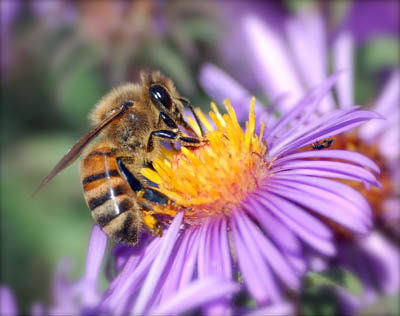Does spring have you thinking about the birds and the bees? Good. As a gardener, you need a variety of insects and other creatures to pollinate your plants.
Most fruits and vegetables, except crops like tomatoes, corn, peppers, eggplant, beans, beets and wheat, need bees to pollinate them. Honeybees are vital for the pollination of the rest of your vegetables and fruits.
Honeybees will pollinate a wide variety of crops throughout the growing season. Unlike other insects that might go from cucumber blossom to dandelion to squash flower, when the honeybee leaves a hive in search of food, it will feed on only one type of flower — whichever type it tasted first on that trip. That way, it picks up and deposits only one kind of pollen, making honeybees particularly efficient at pollinating crops.
A combination of factors has caused the honeybee population to decline in the past 50 years. Honeybees aren’t native to the United States. Colonists carried them here in the 1600s to pollinate their apple trees and provide honey and also wax for candles. For centuries, their numbers expanded, but since the late 1950s, they’ve steadily declined. They die more easily than native bees when disease parasites strike, and they’re less likely to survive a harsh winter.
One threat comes from varroa and tracheal mite, two parasites that can kill honeybees and devastate colonies. Another is colony collapse disorder, a disease that quickly kills off bees in large numbers. Scientists are close to figuring out the cause of the disorder, which appears to be linked to a combination of nutritional deficiencies, pesticides, viruses and other diseases. Entomologists hope that over time, natural selection will result in stronger bees and less threatening mites.
You can help increase the chances of the bees’ survival and ensure your own bountiful fruit and vegetable crops by planting flowers that they like and adding more native plants to your property.
Some plants that are excellent bee attractors are annuals like cosmos and zinnias, which are a favorite of butterflies, too. California poppies and sunflowers are also frequented by bees. Perennial plants they favor are Mexican bush sage, lavender, penstemon, asters, rosemary, Russian sage, coreopsis, gaillardia, echinacea, sedum and erysimum. Native plants that attract both honeybees and native bees include ceanothus, toyon, buckwheat, coyote mint, salvia, ribes and sambucus.
Since pesticides are another deterrent to honeybees’ survival, look for nontoxic ways of controlling garden pests.
Remember that the 1,600 species of our native bees are also in decline — mainly from habitat loss. They are solely responsible for pollinating many of our native plants. Being solitary, they do not make hives, but instead make nests underground. There is one female per nesting hole, and she lays her eggs there. Be sure to leave some unmulched areas near your flowering plants for her to burrow into.
Honeybees and native bees need help to survive, and we’re the ones who need to give it. Besides planting nectar and pollen sources, you can help by buying local honey to support beekeepers.
Jan Nelson, a California certified nursery professional at Plant Works in Ben Lomond, will answer questions about gardening in the Santa Cruz Mountains. E-mail her at ja******@*ol.com.













